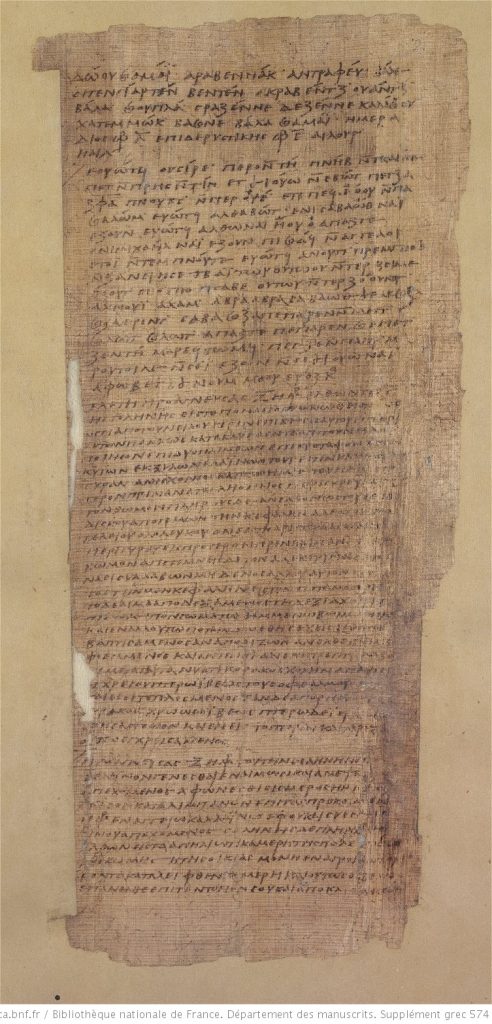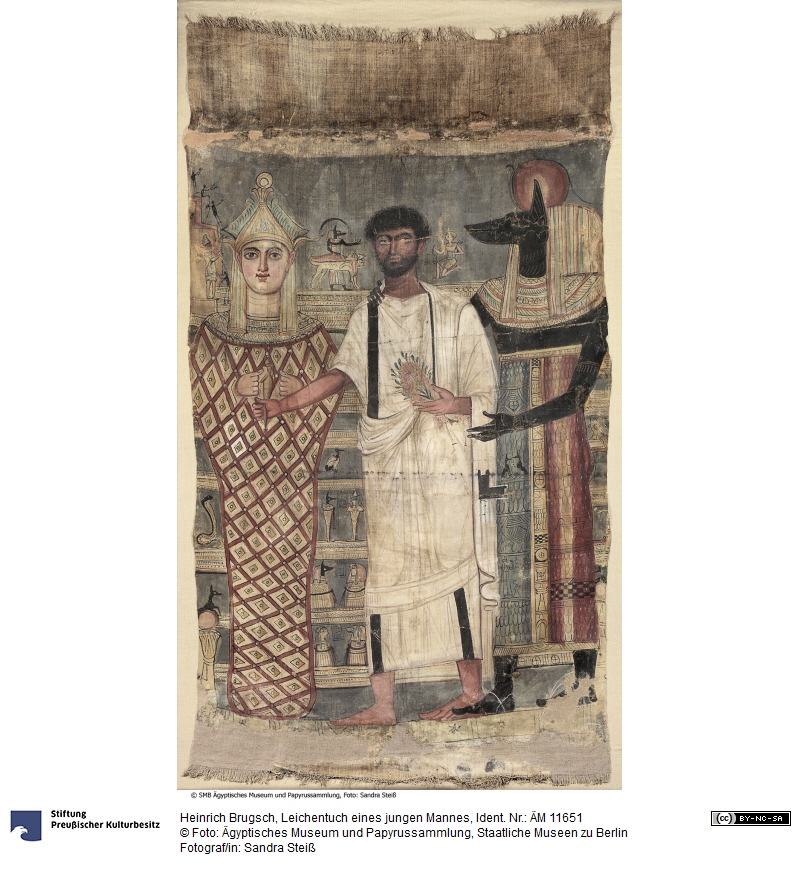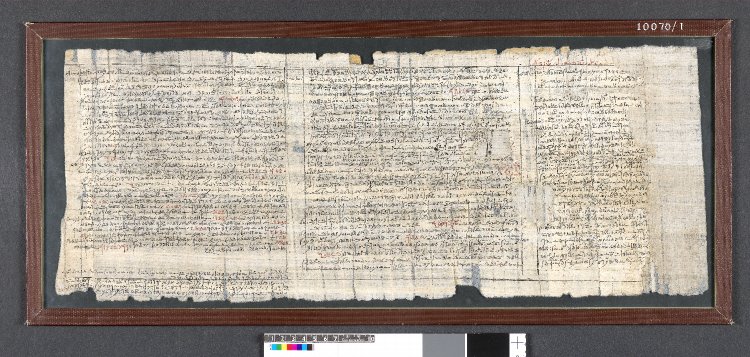
This post is the first in a mini-series about bilingual recipes written in Coptic-Egyptian and Greek from a codex of magical texts dating to the end of 3rd or early 4th century CE – the “Great Magical Papyrus of Paris”, also known as PGM IV (Greek Magical Papyrus 4). The codex contains 72 pages, 66 of which are inscribed with a total of 3,274 lines of text. PGM IV is therefore the lengthiest of all the magical handbooks preserved from antiquity, roughly the dimensions of the average travel guide.
The texts from PGM IV considered in this mini-series are among the earliest evidence for magical texts in Coptic. These recipes are bilingual, written in both Coptic-Egyptian and Greek, but the languages are used in distinct ways. Coptic-Egyptian is used for the ritual invocations, and different “Old Coptic” scripts are used to write them, whereas the instructions are written in Greek. We find similar use of the two different languages in earlier manuscripts of the Graeco-Egyptian magical papyri, although in those, the Egyptian sections are not written in Old Coptic, but in traditional scripts such as demotic or hieratic. We can therefore consider these recipes part of a larger group of ‘Egyptian-Greek bilingual texts’.
PGM IV is contemporary with the earliest evidence for texts written in standardised forms of the Coptic language – and its different dialects. However, the Coptic-Egyptian-language invocations in this codex are much older than the 3rd/4th century CE codex in which they were written – dating back to a time when demotic was still written, and Coptic had not yet been standardised. So, they can be termed both Coptic and Egyptian – “Coptic-Egyptian”. After the turn of the 3rd century there is very little evidence for writing on portable materials, such as papyri or ostraca, in hieroglyphs, hieratic, or demotic. These texts, usually called “Old Coptic”, are at once a connection with a past obsolete textual culture, and a precursor of contemporary and successive textual cultures in Coptic which grow in prominence from the 4th century CE onwards.
PGM IV contains three sets of bilingual recipes broadly concerning divination (practices to acquire foreknowledge), erotic practices (those to satisfy sexual desire), and exorcism (the casting out of demons possessing individuals). It is the first example from the first set of recipes which concerns the remainder of this post – those divinatory practices with which the practitioner could acquire foreknowledge about a particular matter for themselves or their clients. As introduced above, each of these recipes is a “composite”, containing invocations in the Coptic-Egyptian language alongside ritual instructions in Greek in order to produce a bilingual composite.
Looking at the Bilingual Direct-Vision
The “Bilingual Direct-Vision” (PGM IV. 5-51) on page 4 of the codex has the desired outcome of bringing about a theophany – the manifestation of a deity – allowing a practitioner to have a face-to-face encounter with that deity. It is presumably during such an encounter that the practitioner could ask the deity anything and everything that they or their clients wished to know. In the Greek-language ritual instructions it is specified that during the seven days preceding the practice itself the practitioner is directed to become and remain ritually pure – a daily concern for a priest in an Egyptian temple – before preparing an eye ointment.
On the third of the lunar month, the practitioner must then head to ground from which the Nile has recently receded and – during sunrise – build a fire of olive wood between two bricks with a trench dug around it. When the sun has risen, a white rooster is to be beheaded and held between the practitioner’s knees. The head is then thrown into the river, the drained blood drank by the practitioner, and the carcass thrown upon the fire as a burnt offering.
The practitioner must then jump into the river fully-clothed, fully immerse themselves, and then return back to the riverbank without turning their back to the water. Having changed into fresh clothes, the practitioner must then take bile from an owl, and apply it to their eyes using the feather of an ibis. Following all these steps, the text confirms that the practitioner has been “initiated”.
Following this initiation, the practitioner is instructed to recite invocations of magical names followed by those to particular deities, which will cause the invoked deities to manifest. The practitioner’s ritual purity and eye ointment, then, will enable the practitioner to see and communicate directly with those deities.
When we look at the host of deities invoked as part of this practice’s ritual invocations, we find a picture which is quintessential of the centuries of syncretism that had occurred in Egypt by the beginning of the 4th century CE. Following a variety of magical names which derive from Hebrew as well as perhaps Greek, among other groups of sounds which are not easily recognisable, the practitioner is to recite:
Hail him, Osiris – Pharaoh of the Underworld, Lord of Mummification, he who is south of Thinis, who gives answer in Abydos …
PGM IV. 11-25
Hail him, Althabōt. Bring Sabaōth into me!
Hail him, Althōnai … Bring Michael into me, this mighty-one of angels, who is with God.
Hail him, Anubis – he of the district of the face of the son of Isis, he upon his mountain.
Hail them, goddesses.
Hail him, Thoth, the twice great, the wise one.
Hail them, gods.
…
Akshlshha is my name; Sabashha is my true name …
By He in the Underworld; let him join him, He in the Air.
Let them rise up, come in, and answer me concerning the matter about which I ask them.
Here we find the invocations to traditional Egyptian deities, such as Osiris in his iconic position as the ruler of the underworld, as well as the Egyptian practice of mummification, or even his – almost unparalleled – oracular function. And yet, it is actually the Jewish-Christian Ialdabaoth (the first name of the demiurge of Gnostic tradition who declares himself the one and only God, in this text spelt Althabōt) and Adonai (a Hebrew term for Lord as a name of God, in this text spelt Althōnai) who are invoked to fulfil the ritual. After the invocation to Ialdabaoth, the practitioner declares: “Bring Sabaōth to me”, and after the invocation to Adonai, the practitioner declares: “Bring Michael to me – this mighty-one of angels, who is with God”. Although these invocations call upon Osiris, Anubis, Thoth, and other generic Egyptian gods or goddesses, it is not they, but Ialdabaoth and Adonai who are commanded to bring Sabaoth and Michael – presumably the archangel.

The practitioner closes their ritual invocations with the instructions that “the one who is in the Underworld” must join with “the one who is in the Air”. Although it is Osiris who has a traditional association with the Underworld, the dualism in the invocations suggest that, because it is Sabaoth and Michael who are commanded to be brought to the practitioner, these two epithets appear to refer back to those two deities, respectively. Through these epithets, they are commanded to rise up, come to the practitioner, and “answer me concerning the matter about which I ask them”. By “coming in”, then, the invoked deities will manifest before the practitioner, who – through their ritual purity and eye ointment – will, presumably, be able to see and interact with the manifest deities.
Another interesting feature about this text is that it has a parallel in a series of ritual invocations in a Demotic magical text for similar function from P. London-Leiden (PDM xiv. 627-635) (Column 21, Lines 1-9). Nine lines of Demotic correspond in part to several lines of the ritual invocations written in Old Coptic in PGM IV, such as the invocation to Osiris, but also differ in notable ways. Instead of invoking Sabaoth, for example, “the light” is instead directed to “come in” to the practitioner. Nonetheless, in another set of ritual invocations written in Demotic elsewhere in that same papyrus, Sabaoth is invoked to “come down” and bring a deity called “Boēl” to the practitioner so that he can “inquire for me”. Therefore, we know that Sabaoth was already a deity incorporated into magical practices transmitted in the Egyptian language even before this Old Coptic text was copied. Indeed, it could be that this Old Coptic text is directly transcribed from a similar Demotic text in an earlier century.

As the first recipe of magical practices in a series that fill the first three pages of PGM IV, this bilingual direct-vision encapsulates the diversity of the Graeco-Egyptian magical tradition that was the precursor to the later traditions found in Coptic magical texts. That being said, such texts also provide evidence for practices which in some cases directly influenced, and in others were entirely separate from, the later Coptic tradition. In later posts, then, by looking at the other bilingual recipes from this extraordinary codex, we will see both the successors of more ancient, as well as the predecessors of subsequent, traditions of magical practice.
Bibliography and Further Reading
For the most recent study of this recipe, and bibliography of past treatments, see section §4.1 in Chapter 4 of
Love, Edward O. D. Code-Switching with the Gods: The Bilingual (Old Coptic-Greek) Spells of PGM IV (P. Bibliothèque nationale supplement Grec. 574) and their Linguistic, Religious, and Socio-cultural Context in Late Roman Egypt. Berlin: De Gruyter, 2016. URL
